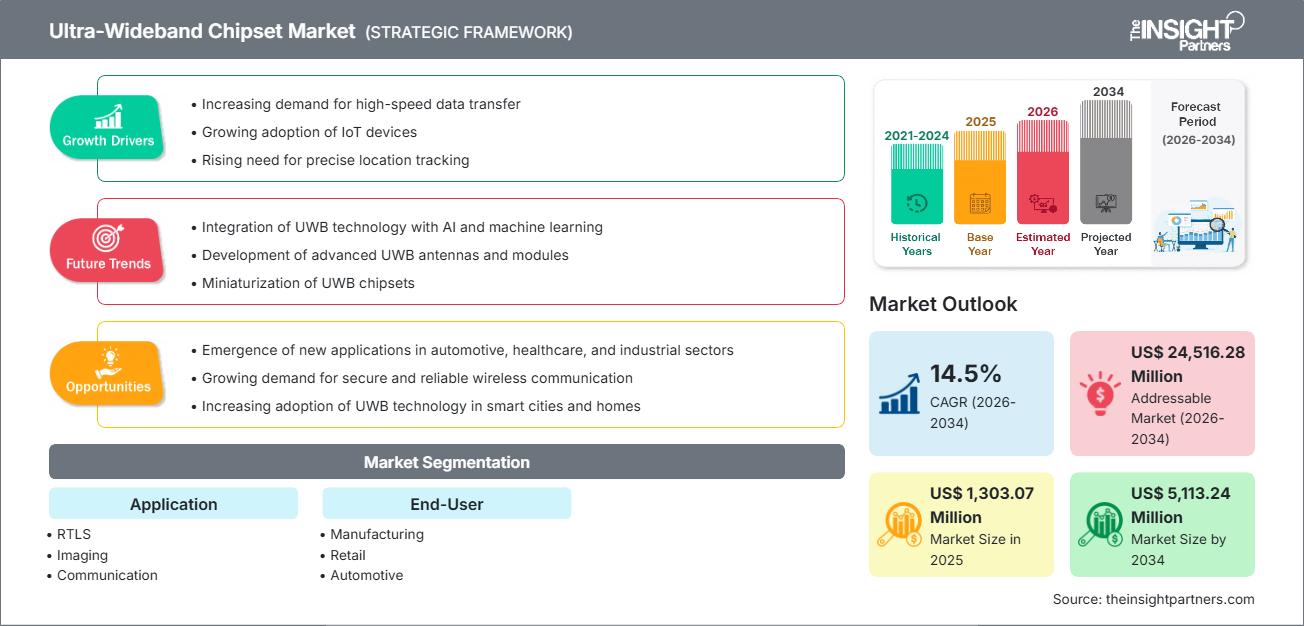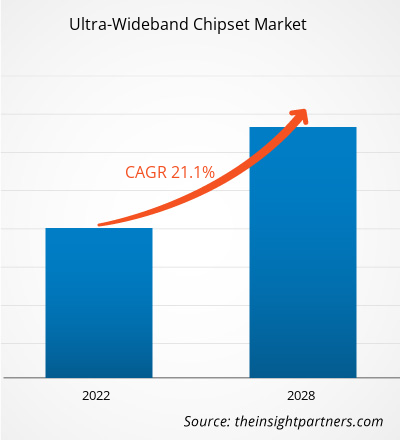2025 年超宽带芯片组市场规模为 13.0307 亿美元,预计到 2034 年将达到 51.1324 亿美元,2026 年至 2034 年的复合年增长率为 14.5%。
超宽带芯片组市场分析
由于实时定位系统 (RTLS) 中超宽带 (UWB) 技术的应用日益广泛,对高精度资产跟踪的需求不断增长,以及 UWB 技术在消费和工业设备中的集成,预计超宽带 (UWB) 芯片组市场将强劲增长。
与传统的实时定位系统(例如 RFID、基于 Wi-Fi 的定位)相比,超宽带技术具有更高的精度、更宽的带宽、更低的功耗和更好的抗干扰能力,因此对于需要精确的室内/室外定位和安全通信的应用来说很有吸引力。
此外,物联网、智能设备、可穿戴电子产品、汽车应用(例如安全访问、车辆定位)和工业自动化等领域的增长——所有这些都受益于超宽带芯片组——正在推动需求。
超宽带芯片组市场概览
超宽带芯片组是实现超宽带(UWB)通信的集成电路。UWB 是一种无线技术,利用宽频频谱进行短距离、高精度、低功耗的数据传输和测距。这些芯片组对于实现精确的实时定位系统(RTLS)、安全访问控制、设备间通信以及消费电子、汽车、工业、医疗保健和零售等行业的各种应用至关重要。
UWB 芯片组能够实现厘米级的定位精度、低延迟、抗干扰能力和节能通信,从而帮助设备制造商和系统集成商提供强大的性能,无论是用于跟踪仓库中的资产、实现智能手机的空间感知,还是为汽车提供安全的无钥匙进入功能。
随着对精确定位、实时跟踪和安全通信的需求不断增长,UWB 芯片组正在成为多个垂直行业的关键基础设施组件。
根据您的需求定制此报告
您可以免费获得任何报告的定制服务,包括本报告的部分内容、国家/地区层面的分析、Excel 数据包,以及面向初创企业和高校的优惠折扣。
超宽带芯片组市场:战略洞察

-
获取本报告的主要市场趋势。这份免费样品将包含数据分析,内容涵盖市场趋势、估算和预测等。
超宽带芯片组市场驱动因素和机遇
市场驱动因素:
- 高精度定位和跟踪需求:制造业、物流业、零售业、医疗保健业和智能基础设施对精确的实时定位系统 (RTLS) 的需求不断增长,推动了 UWB 技术相对于精度较低的替代方案的普及。
- 消费电子产品和智能设备中日益增长的集成:随着智能手机、可穿戴设备、智能家居设备和物联网设备的普及,UWB 芯片组越来越多地被嵌入其中,以实现空间感知、安全通信和基于距离的功能。
- 汽车应用日益普及:UWB 正被用于安全汽车进入、定位和通信功能,从而推动了汽车制造商对芯片组的需求增长。
- 对低功耗、抗干扰通信的需求:UWB 具有低延迟、抗多径/干扰能力强、节能等固有优势,使其适用于需要可靠性和精确性的现代无线系统。
市场机遇:
- 跨行业扩展和新兴技术应用案例:随着物流、智能制造、医疗保健资产跟踪、零售库存管理和智能家居/办公自动化等领域的需求不断增长,UWB 芯片组的应用预计将会扩大。
- 物联网和智能设备普及:随着物联网生态系统在全球范围内扩展,将超宽带芯片组嵌入到更多设备中具有相当大的增长潜力,包括可穿戴设备、智能标签和设备间通信。
- 汽车和移动出行创新:UWB 在车辆访问、安全通信和定位方面的应用,为芯片组供应商与汽车 OEM 厂商的合作带来了巨大的机遇。
- 从传统跟踪/通信技术迁移:随着企业和消费者对准确性和安全性的要求越来越高,UWB 成为旧系统(例如 RFID、基本蓝牙)的替代品,从而推动了芯片组的普及。
超宽带芯片组市场细分分析
按申请方式:
- 实时定位系统(RTLS)
- 成像
- 沟通
按最终用户/行业垂直领域划分:
- 制造业
- 零售
- 汽车
- 卫生保健
- 消费电子产品
按地理位置:
- 北美
- 欧洲
- 亚太地区
- 南美洲和中美洲
- 中东和非洲
超宽带芯片组市场区域洞察
The Insight Partners 的分析师对预测期内超宽带芯片组市场的区域趋势和影响因素进行了详尽的阐述。本节还探讨了北美、欧洲、亚太、中东和非洲以及南美和中美洲等地区的超宽带芯片组市场细分和地域分布。
超宽带芯片组市场报告范围
| 报告属性 | 细节 |
|---|---|
| 2025年市场规模 | 13.0307亿美元 |
| 到2034年市场规模 | 51.1324亿美元 |
| 全球复合年增长率(2026-2034 年) | 14.5% |
| 史料 | 2021-2024 |
| 预测期 | 2026-2034 |
| 涵盖部分 |
通过申请
|
| 覆盖地区和国家 |
北美
|
| 市场领导者和主要公司简介 |
|
超宽带芯片组市场参与者密度:了解其对业务动态的影响
超宽带芯片组市场正快速增长,这主要得益于终端用户需求的不断增长,而终端用户需求的增长又源于消费者偏好的转变、技术的进步以及消费者对产品优势认知的提高。随着需求的增长,企业不断拓展产品和服务,持续创新以满足消费者需求,并把握新兴趋势,这些都进一步推动了市场增长。

- 获取超宽带芯片组市场主要参与者概览
超宽带芯片组市场份额地域分析
根据 The Insight Partners 的报告,2021 年,该市场的区域分布覆盖北美、欧洲、亚太地区、拉丁美洲、中东和非洲。
从历史上看,亚太地区一直占据着相当大的收入份额(在各地区中领先),其次是北美和欧洲。
预计各地区的增长情况将因技术采用率、工业化程度、消费电子产品普及率、汽车集成度和物联网基础设施发展而有所不同,亚太地区和新兴经济体尤其具有发展潜力。
竞争格局与参与者密度
超宽带芯片组市场的特点是众多全球厂商和细分领域芯片组开发商并存。这些厂商通过以下方式实现差异化:
- 将超宽带芯片组集成到适用于消费电子设备和物联网的多功能集成电路中。
- 先进的芯片组设计,优化了功耗、带宽和抗干扰能力。
- 与设备制造商(智能手机、汽车OEM、工业设备制造商)开展战略合作,将UWB技术嵌入下一代产品中。
- 旨在通过创新,为不同垂直领域的实时定位系统 (RTLS)、通信和成像应用量身定制超宽带 (UWB) 技术。
超宽带芯片组市场的主要运营公司
- ALEREON公司
- 苹果公司
- Bespoon SAS
- 迪卡韦夫有限公司
- 太阳诱电株式会社
- 约翰逊科技公司
- 诺维尔达
- 恩智浦半导体公司
- Pulse-Link公司
研究过程中分析的其他球员包括:
- 德州仪器公司
- 意法半导体
- 三星电子有限公司
- 斑马技术公司
- 索尼公司
- 英飞凌科技股份公司
- 村田制作所有限公司
- 莱特波因特公司
- Sevio Networks sro
- 纳米电子技术有限公司
超宽带芯片组市场新闻及最新进展
- The Insight Partners 的全球报告再次证实了强劲的增长势头,预计到 2028 年,UWB 芯片组市场将达到 19.0646 亿美元。
- 由于 UWB 具有更高的精度和取代传统跟踪/通信系统的能力,因此 UWB 在 RTLS、消费设备和汽车领域的日益普及被认为是关键的增长驱动因素。
超宽带芯片组市场报告涵盖范围和成果
The Insight Partners发布的《超宽带芯片组市场规模及预测(2021-2034)》报告提供了以下信息:
- 针对全球、区域和国家层面的关键细分市场,提供详细的市场规模和预测。
- 分析市场趋势、增长驱动因素、机遇和潜在市场动态。
- 按应用、最终用户和地理位置进行细分。
- 领先芯片组供应商的竞争格局及公司概况。
- 历史分析(2 年)、基准年、预测(7 年)及复合年增长率
- PEST和SWOT分析
- 市场规模、价值/数量 - 全球、区域、国家
- 行业和竞争格局
- Excel 数据集
近期报告
客户评价
购买理由
- 明智的决策
- 了解市场动态
- 竞争分析
- 客户洞察
- 市场预测
- 风险规避
- 战略规划
- 投资论证
- 识别新兴市场
- 优化营销策略
- 提升运营效率
- 顺应监管趋势






















 获取免费样品 - 超宽带芯片组市场
获取免费样品 - 超宽带芯片组市场